Author: Frank, PANews
The extreme volatility of the cryptocurrency market is closely linked to the extreme swings in investor sentiment, with the "Fear and Greed Index" serving as an intuitive measure of investor psychology. On April 7, concerns over increased global tariffs triggered a significant shock in the global financial markets, leading to a surge of panic.
Looking back, since 2018, the crypto market has experienced a total of 239 moments of "extreme fear" where the index fell below 20. This article does not intend to amplify the negative sentiment in the market but aims to systematically review these key moments, learn from history, and attempt to uncover potential cyclical patterns behind them. PANews' research focuses on the distribution characteristics and duration of these panic moments, analyzing whether they contain noteworthy market signals.
2018: Year of Panic Under Regulatory Shadows
From the perspective of the panic index, this period is characterized by sporadic panic events over a long duration. Starting in February 2018, BTC rapidly fell 70% from its peak of $19,000 to around $5,900 within 50 days, marking the onset of the first panic.

During several bottoming processes, panic sentiment emerged in the market. Statistically, there were 93 moments in 2018 where the panic index fell below 20, making it the year with the most panic moments. Notably, on February 5, the panic index hit a low of 8, and from August 20 to September 11, it persisted for 23 days, followed by another 27 days from November 20 to December 16.
From a short-term market perspective, these panic phases were almost all short-term bottoms. After the panic, the market experienced varying degrees of brief rebounds. However, these rebounds ultimately failed to establish new trends and instead became additives to the market's sluggishness.
Here are the influential news factors behind these panic moments:
- February 4-5, 2018: The SEC launched a large-scale ICO investigation; several banks banned the use of credit cards to purchase Bitcoin.
- March 28-April 1, 2018: The SEC announced it would begin regulating cryptocurrency institutions.
- May-June 2018: The South Korean cryptocurrency exchange Coinrail was hacked, resulting in losses exceeding $40 million; the CFTC issued subpoenas to several major exchanges, including Coinbase, Kraken, and Bitstamp.
- August-September 2018: The SEC delayed its decision on Bitcoin ETF applications, and five Chinese ministries issued warnings against the risks of "virtual currency" speculation.
- November 20-December 16, 2018: Bitcoin's price fell 80% from its peak, losing nearly a third of its value in a week, reaching a low of about $3,100 in December 2018. The growth of Bitcoin miners halted in August, and hash power began to decline significantly in November.
From these major news influences, the panic in 2018 was largely driven by regulatory impacts, with news from regulatory bodies like the SEC and CFTC creating a climate of fear.
After these panic moments, the market entered a rising cycle following approximately four months of consolidation.
2019: Panic Selling After a Mini Bull Market
The panic moments in 2019 were significantly fewer than in 2018, with the index falling below 20 only 20 times. This phase can be divided into two parts: one extending from the end of the 2018 bear market, and the other caused by the first rapid decline after reaching a peak. Particularly during the pullback phase after the rise, the resulting panic was even more severe than at the end of the bear market. On August 21, the panic index dropped to 5, marking the lowest panic index in crypto history. However, this extreme panic was primarily due to continuous pullbacks following a frenzied rise, making the market extremely fragile.

In fact, the panic moments in 2019 were gradually less influenced by news, but hacker attacks and security vulnerabilities still had a significant impact on the entire market. Throughout 2019, about 10 major exchanges reported being hacked, with Binance's theft of 7,000 Bitcoins in May drawing market attention.
Additionally, that year, China began implementing restrictive policies on Bitcoin mining, leading many miners to migrate overseas. The several crashes in 2019 seemed to lack direct news sources, appearing more like self-regulation of the market.
2020: "Black Swan" on March 12 Leads to 43 Days of Panic
In the ranking of panic moments in the crypto market, 2020 was undoubtedly the year with the most severe pain. Although the panic moments were concentrated in March and April, with no instances of the index falling below 20 for the rest of the year.
However, the crash on March 12 caused the market to remain in a state of panic from March to April. According to PANews statistics, in March 2020, there were 6 days where the panic index fell below 10, marking a historical low, and in March and April, the market experienced 43 days of extreme panic with the index below 20, making it the two months with the most concentrated panic in crypto history.
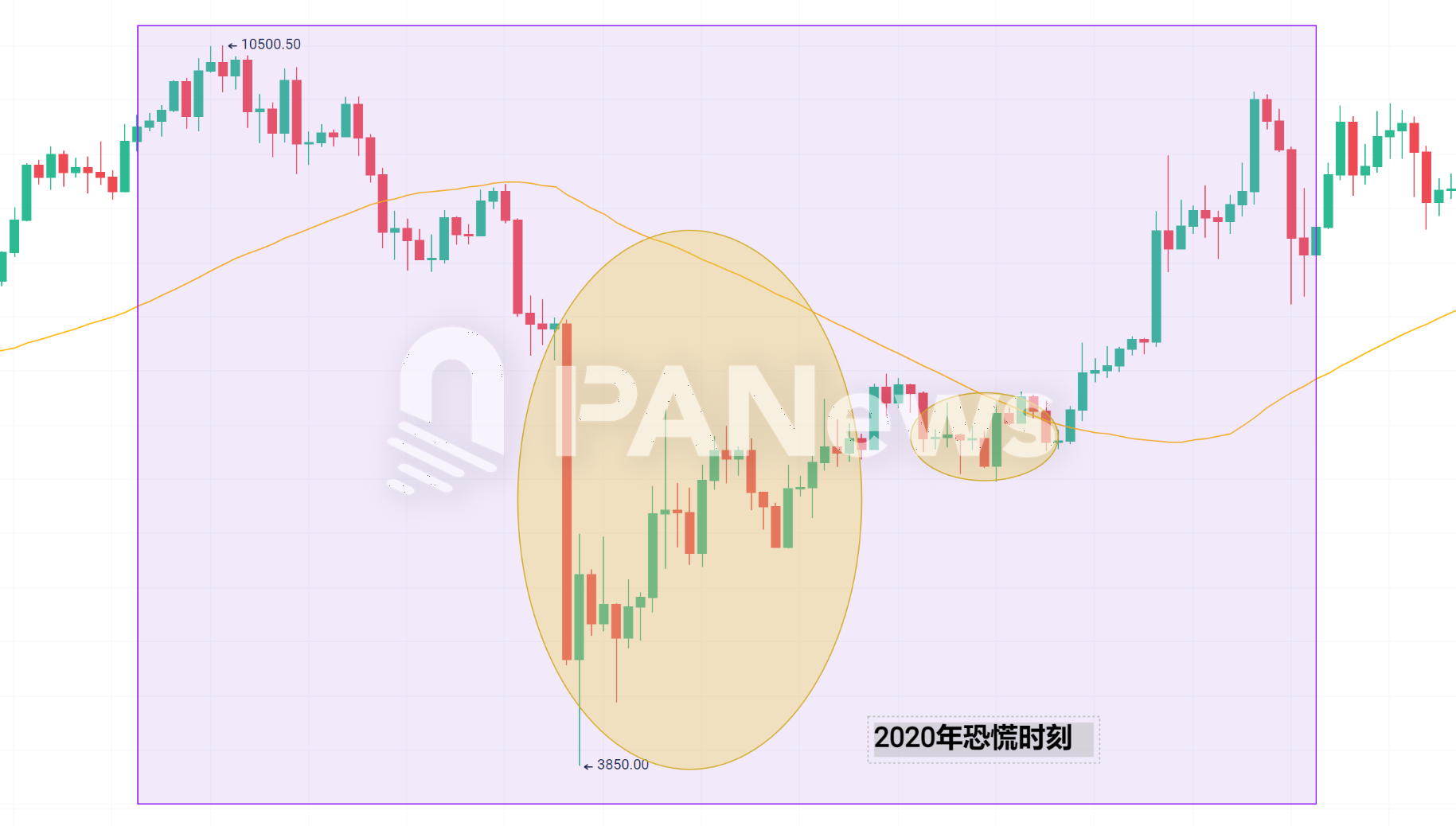
The panic in March 2020 was primarily driven by the outbreak of the COVID-19 pandemic. On March 12, the global financial market faced "Black Thursday." As the market fell, high-leverage positions were massively liquidated in a short time, causing Bitcoin to drop 51% in one day.
Fortunately, for most of the remaining time in 2020, the market remained optimistic. Following the significant turning point on March 12, the cryptocurrency market entered a new upward cycle. According to CoinGecko's report, the market capitalization of the top 30 cryptocurrencies grew by 308% in 2020, surpassing the 62% growth of 2019. Bitcoin soared from a low of $3,850 to a peak of $64,895, marking a nearly 17-fold increase over 400 days.
2021: FUD Strikes and Market Turmoil
In 2021, the market faced another severe downturn, caused by multiple factors. First, Tesla CEO Elon Musk announced on May 12 that Tesla would suspend the use of Bitcoin for car purchases due to concerns about Bitcoin mining's environmental impact. Second, the People's Bank of China reiterated on May 18 that digital tokens could not be used as currency and prohibited financial institutions and payment agencies from providing services related to cryptocurrencies, further intensifying market sell-off pressure.
The subsequent market entered a state of gloom, with market sentiment remaining in a panic state until the consolidation phase before August.
However, in August, the crypto market experienced another wave of significant upward movement, with Bitcoin's price reaching a high of $69,000. Subsequently, in December, as the market entered a new round of decline, the crypto market fell into panic once again.
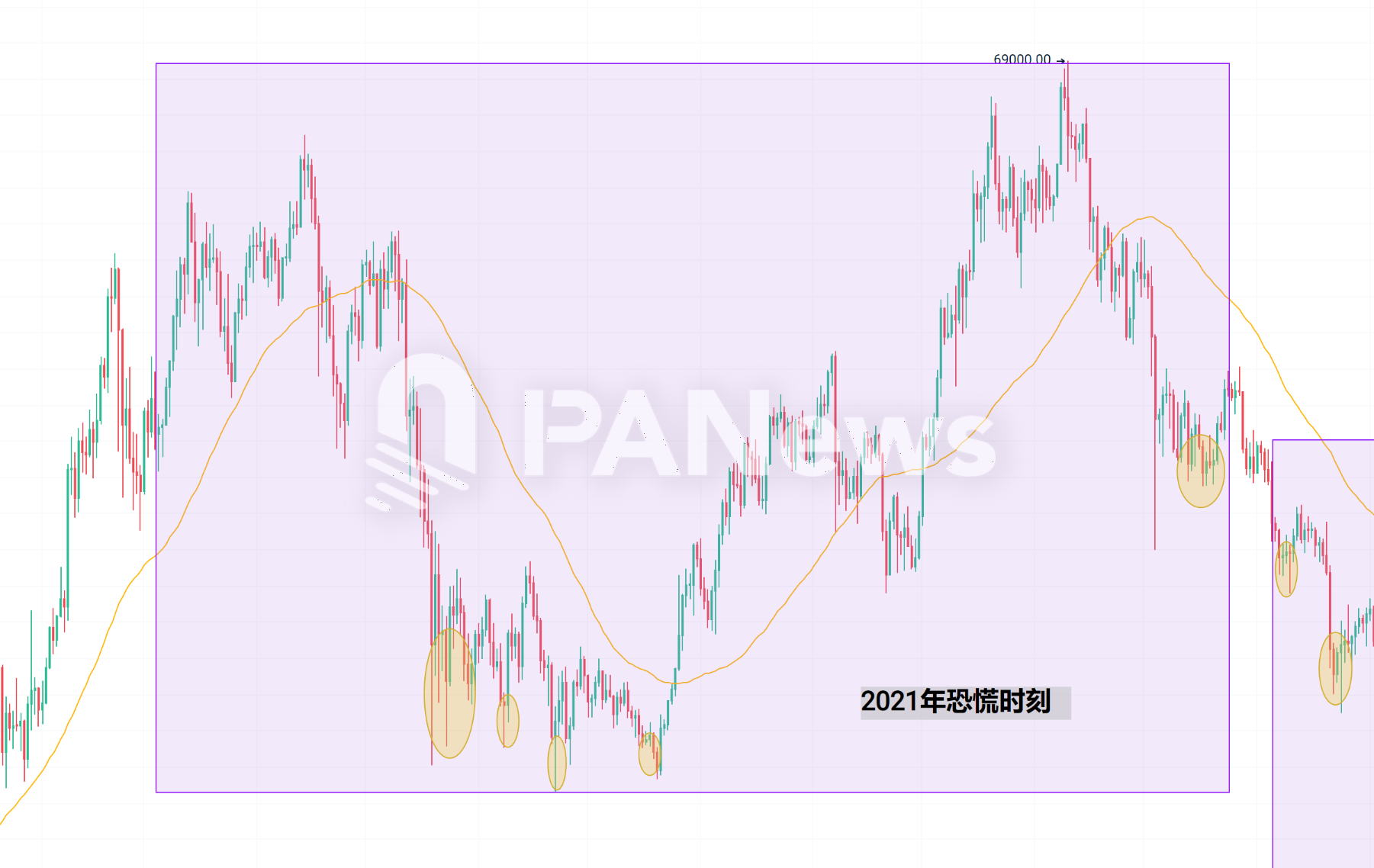 Overall, the panic moments in 2021 essentially marked the end of a rising trend.
Overall, the panic moments in 2021 essentially marked the end of a rising trend.
2022: Luna Collapse Brings 65 Days of Panic
The panic occurrences in 2022 can be divided into three parts, with the first two panic events continuing the downward trend from 2021. The third panic was a prolonged period of 65 days, marking the longest duration of panic in history. The panic index fell to a low of 6, second only to the lowest point of 5 in 2019.
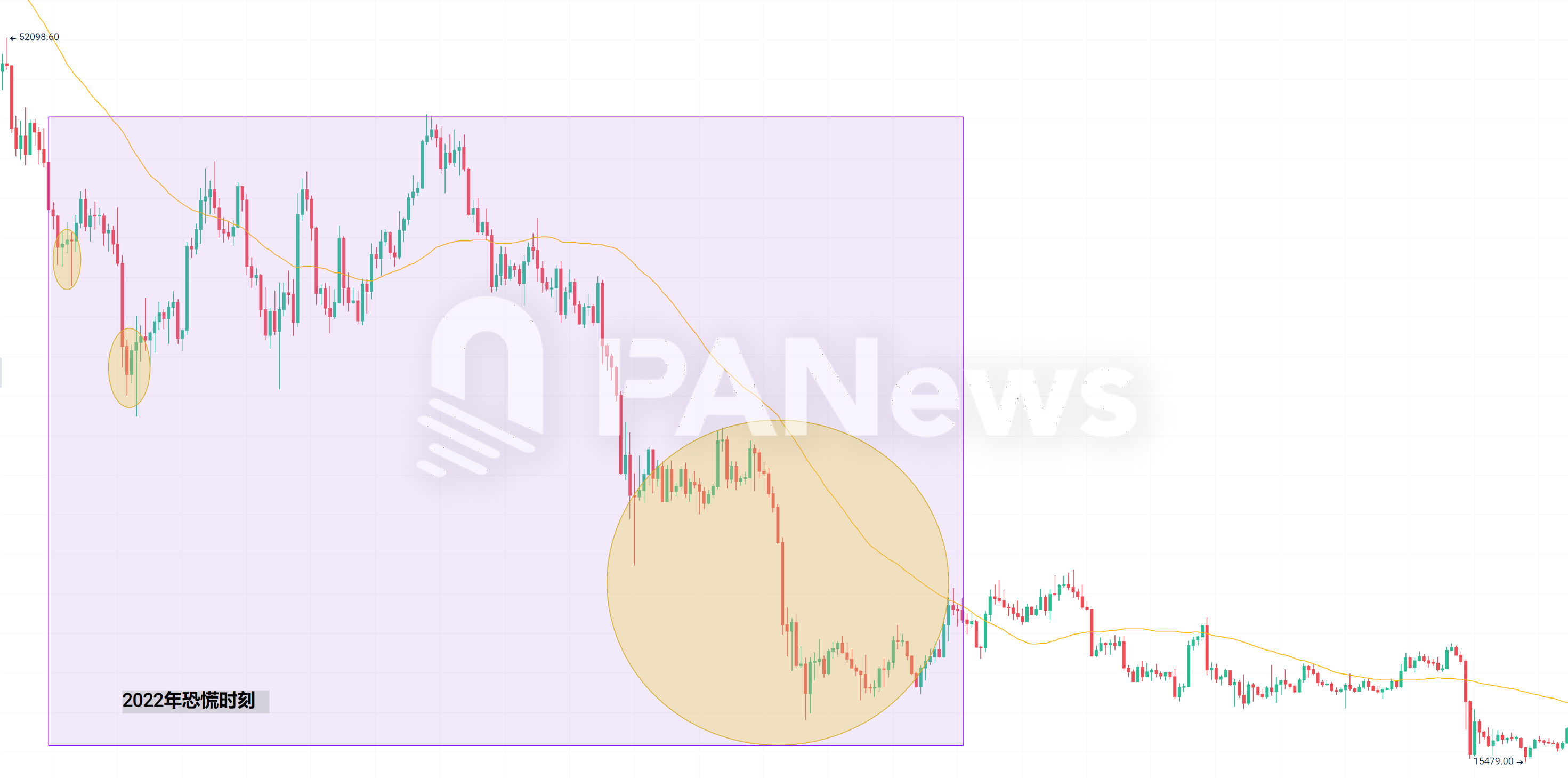
The major collapse in 2022 was primarily due to the Terra/Luna collapse. On May 9, UST decoupled from the US dollar, and the Terra blockchain was paused. Celsius Network suspended all transfers and withdrawals on June 13. Three Arrows Capital (3AC) defaulted in June and was ordered to liquidate in July. Bitcoin fell below $30,000 for the first time since July 2021. On July 13, the global cryptocurrency market cap dropped to $871 billion.
However, the 2022 collapse was not solely due to Luna's decoupling; the FTX exchange's collapse in November also plunged the market into panic, with Bitcoin dropping to a low of $15,479, the lowest point in nearly three years. Yet, this collapse did not seem to show much fluctuation in the panic index, which fell to a low of 20.
This indicates that when the market enters the late stages of a bear market, events that are intuitively felt by the market often do not show much in the index. Conversely, when the market appears to be in panic but the index does not fluctuate significantly, it may also signal a forthcoming change in the market.
2023-2024: Panic Eases and Market Warms Up
After the market bottomed out in 2022, it fully returned to a long-term upward cycle, with the panic index not falling below 20 throughout 2023. It wasn't until August 2024 that it dropped to 17, marking a moment of extreme panic. However, this panic was caused by a rapid pullback during the upward process.
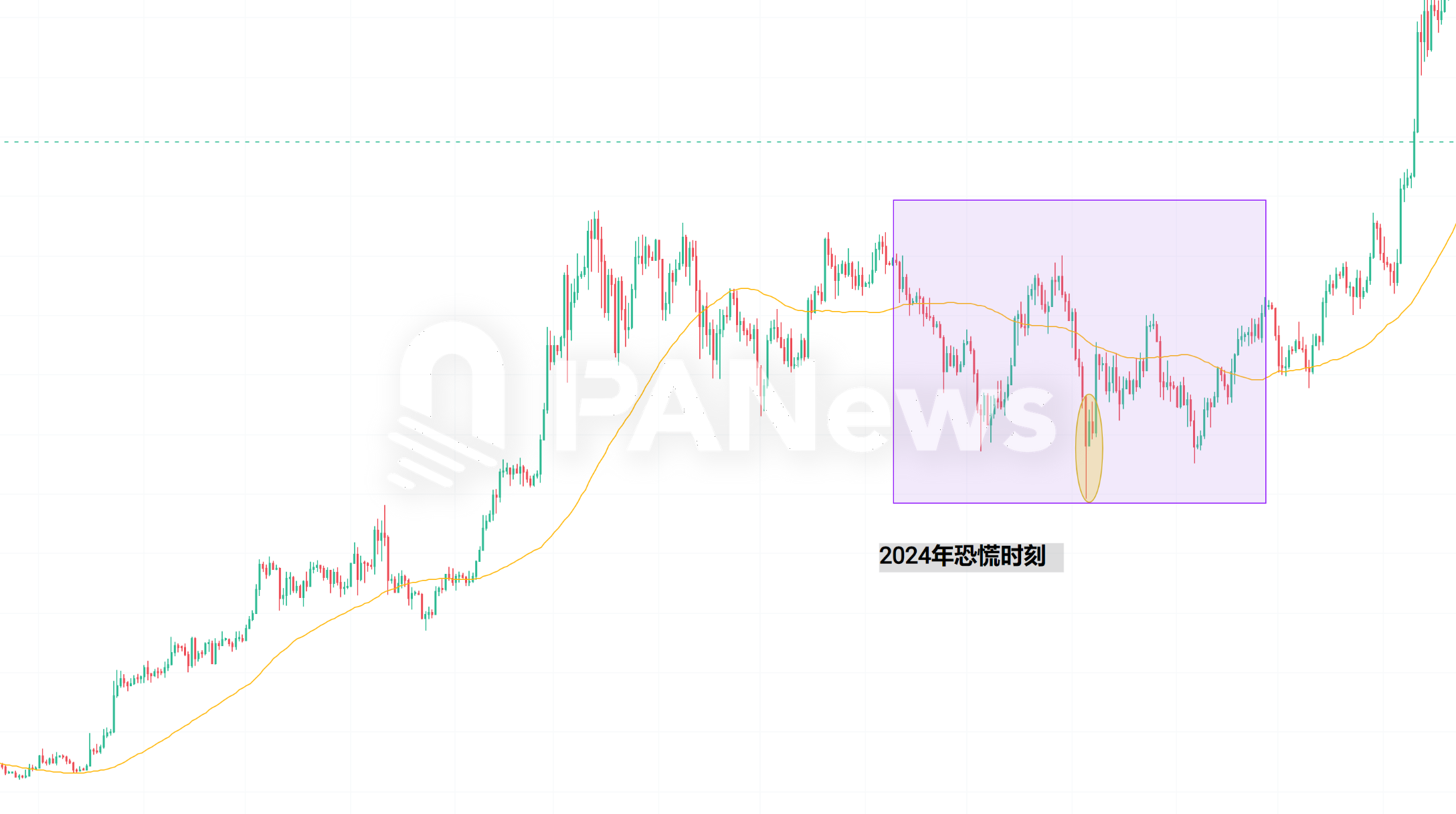
2025: Panic Resurfaces and Future Uncertainty
The panic moments in 2025 seem to have become frequent again. As of April 8, the panic index has fallen below 20 three times. Among these, it dropped to a low of 10 on February 26, then to 15 on March 3. On April 7, influenced by the Trump administration's global tariff increases, the global financial market faced a major crash, with Bitcoin falling below $75,000. However, the panic index did not drop below 20, similar to the signals given during the FTX collapse in November 2022. The difference is that after the FTX collapse, the crypto market truly hit rock bottom and began to rebound, growing into a bull market. This time, it remains uncertain whether the tariff impact marks the beginning of a decline or a signal of a bottom.
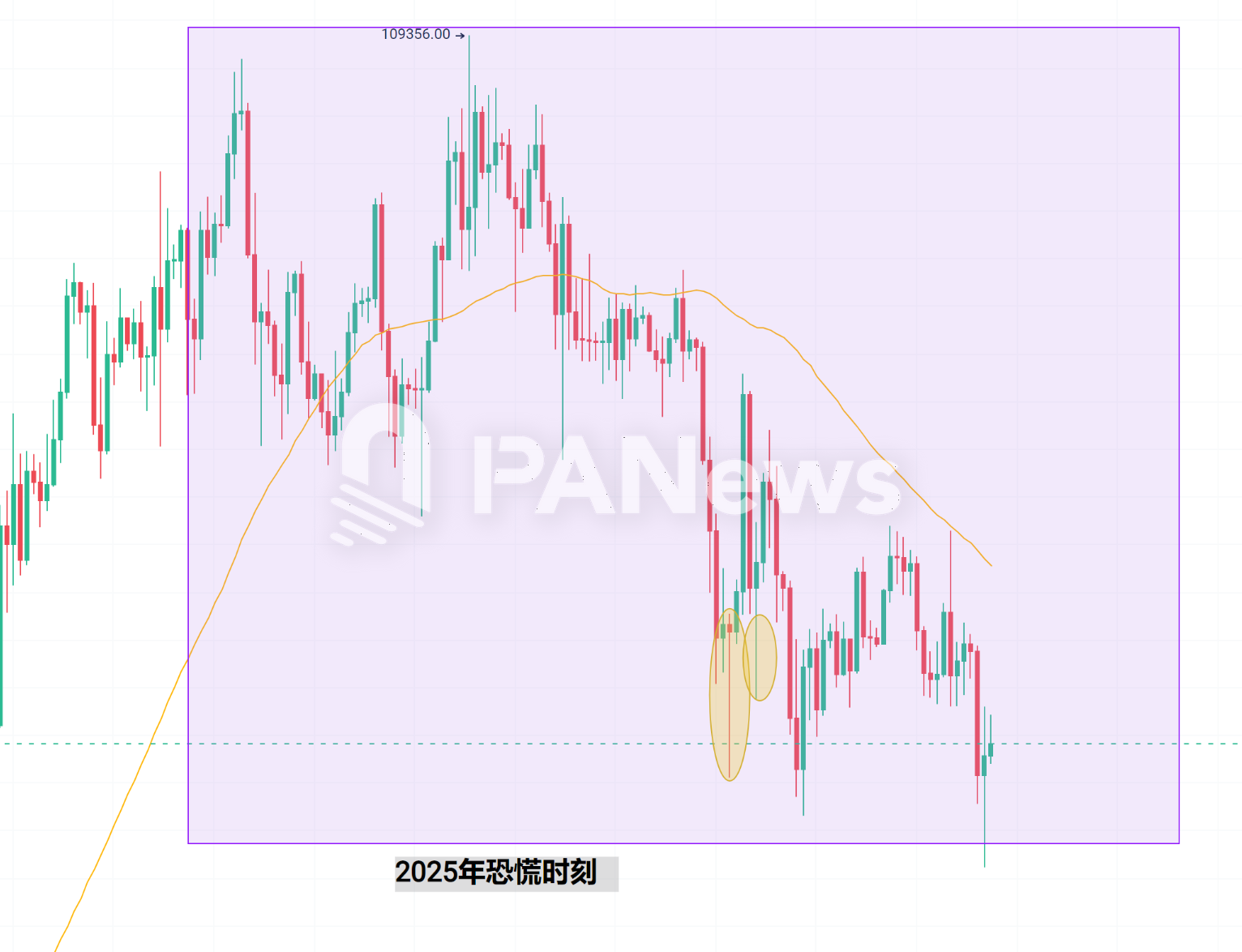
Reflections Behind 239 Moments of Panic
A comprehensive review of all panic moments since the inception of the panic index shows that, according to PANews statistics, the cryptocurrency market has experienced a total of 239 instances of extreme panic (values below 20) over more than six years. In most cases, these moments of panic were triggered by sharp market declines and occurred during a short-term phase of bottoming.

Through further analysis of these panic moments, PANews has summarized the following interesting patterns.
Panic moments are generally concentrated in two phases: one is at the end of a bear market, where the market becomes more sensitive to fluctuations due to shrinking liquidity, often leading to black swan events like March 12 or the FTX collapse. The other phase occurs in the early stages of a bull market's end, when prices peak for the second time and begin to decline, causing panic selling that can easily lead to extreme panic sentiment. Conversely, during a sustained upward trend, the panic index has rarely fallen below 20.
The duration of individual panic moments seems to hold more reference value. Whether it was the 27 days below 20 from November to December 2018, the 43 days below 20 from March to April 2020, or the 65 days below 20 from May to July 2022, these concentrated periods of continuous panic often indicate that the market is nearing a bottom. When the market remains in extreme panic for an extended period, it marks the beginning of a reversal.
Sporadic panic moments with longer intervals often provide little reference value for judging market trends. Many in the market believe that extreme panic typically leads to a rebound. While this pattern does hold true in short-term scenarios, when viewed over a larger cycle, these sporadic panic moments with longer intervals do not indicate a market reversal; they often suggest that the market is still in a bear phase (as seen in the panic moments from February to November 2018 or July to September 2019).
The number of panic moments has decreased in recent years, with 93 instances in 2018, 73 in 2022, but only 1 in 2023 and 2024. On one hand, the growing size of the cryptocurrency market has led to less volatility compared to the past, thus reducing the occurrence of panic moments. On the other hand, after two relatively stable years, the market may enter a phase of more frequent panic moments in 2025.
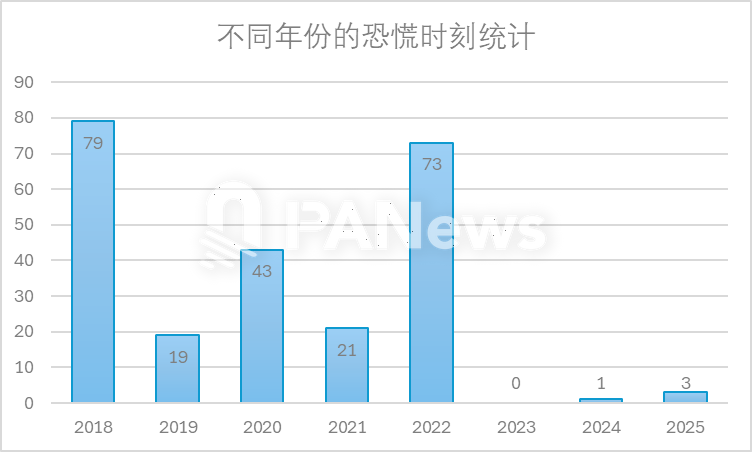
Looking back at the 239 instances of "extreme panic" from 2018 to early 2025, we can glimpse certain patterns in the tides of cryptocurrency market sentiment: panic often manifests at the tail end of a bear market and in the early stages of a bull market's decline. Among these, prolonged periods of deep panic are more indicative of an approaching phase bottom compared to sporadic panic, confirming the market philosophy of "extreme conditions lead to reversals."
History does not repeat itself exactly, but it often bears striking similarities. Understanding the signals conveyed by the panic index, carefully distinguishing between short-term fluctuations and long-term trends, and integrating macro events with changes in market structure for comprehensive judgment will be crucial for investors navigating the unpredictable world of cryptocurrency. Ultimately, whether the current market is the prelude to a new round of declines or another "panic is an opportunity" bottom signal remains to be seen with time.
免责声明:本文章仅代表作者个人观点,不代表本平台的立场和观点。本文章仅供信息分享,不构成对任何人的任何投资建议。用户与作者之间的任何争议,与本平台无关。如网页中刊载的文章或图片涉及侵权,请提供相关的权利证明和身份证明发送邮件到support@aicoin.com,本平台相关工作人员将会进行核查。




